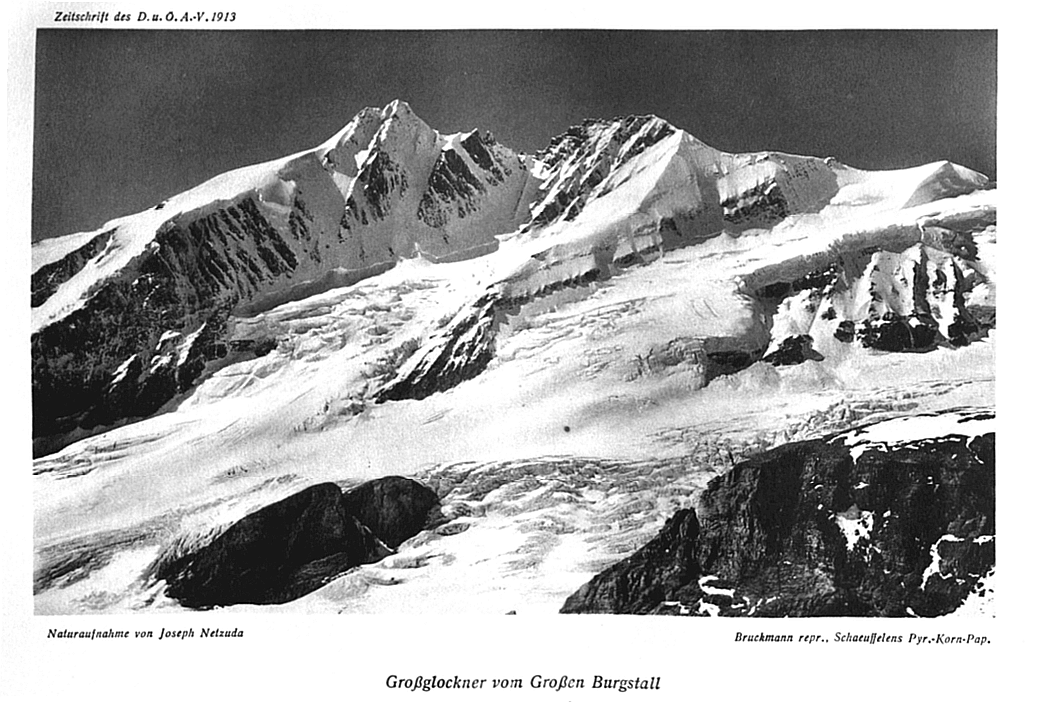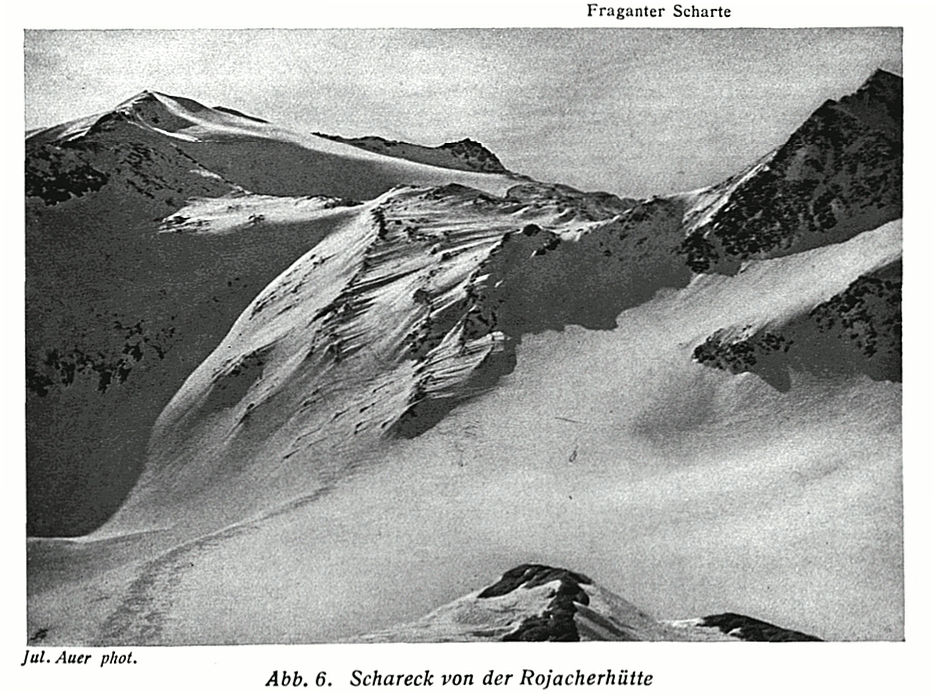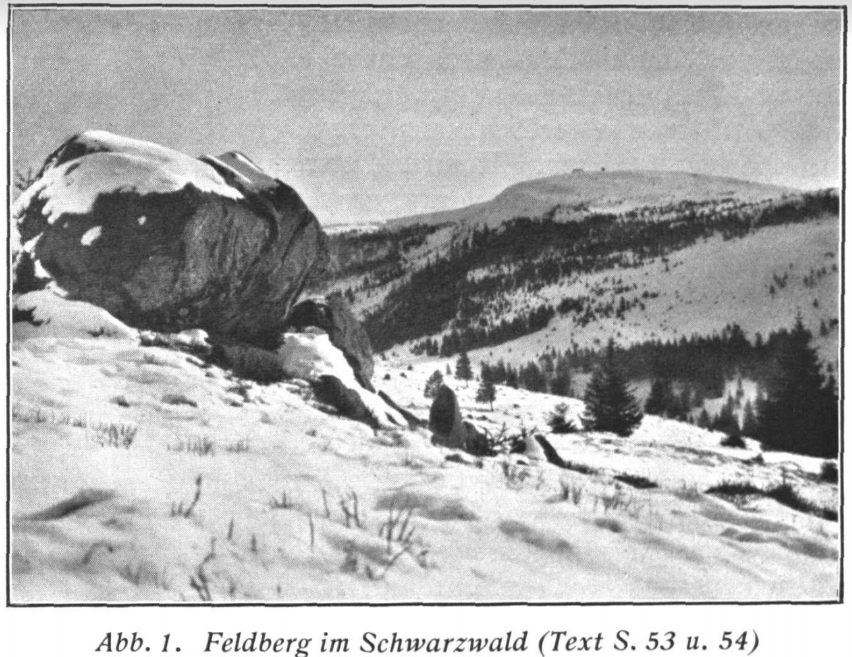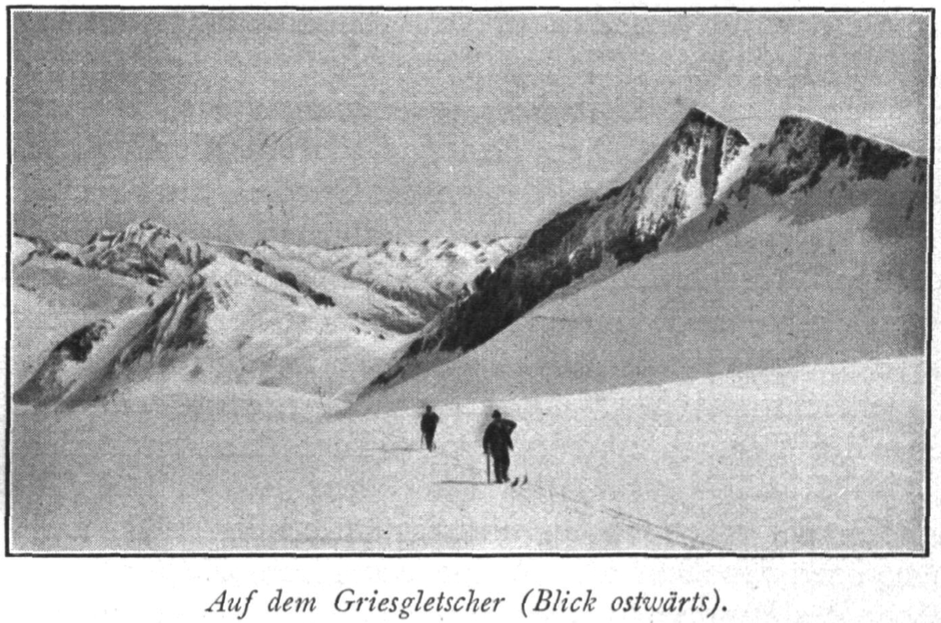GRANATSPITZE, 3085 m, LANDECKER SONNBLICK, 3087 m
(S.) Nach einer nächtlichen Bahnfahrt von Wien und einer einstündigen Wagenfahrt von Uttendorf im Stubachtale trafen Herr Ing. Assanek und ich am Morgen des 2. Juni 1911 beim schmucken Wirtshaus in der Schneiderau ein. Wir wünschten dem Wirte, daß er nicht abergläubisch sei, denn sonst müßte ihm die geringe Zeche der ersten Saisongäste noch sorgenvolle Stunden bereitet haben. Nach einfachem Frühstück verließen wir die gastliche Stätte und wanderten taleinwärts der Rudolfshütte zu. — Vom Großvenediger und vom Hohen Sonnblick aus hatte ich all die herbe Schönheit der Glockner- und Granatspitzgruppe in ihrer Winterpracht bewundern können und unwiderstehlich zog es mich hin nach dem Zauber, den der Winter in seinen letzten Bollwerken so reichlich entfaltete.
Allein der angebrochene trübe Morgen, der sich von seinen Vorgängern nur dadurch unterschied, daß er voraussichtlich seine feuchten Schönheiten etwas später zu zeigen beabsichtigte als diese, war so recht geeignet, unsere Siegeszuversicht nicht gerade bis zum Gipfel des Großglockners emporwachsen zu lassen.
Von den Schönheiten des »Fischerweges", der uns längs der schäumenden Ache durch prächtigen Hochwald zu den anmutigen Almen des Enzingerbodens mit seinen vormärzlichen Landschaften führte, von dem von Schnee umgrenzten, verträumten Grünsee zwischen seinen ragenden Wänden, mit all der schwermütigen Schönheit eines kleinen Hochsees und dem zur Rast einladenden Französach-Jagdhause in winterlicher Umgebung will ich hier nicht erzählen. Denn dies wäre zu stark im Widerspruche mit unserem Geknurre über diesen "Schinder", wobei zugestanden werden muß, daß die Unparteilichkeit unseres Urteiles ebenso wie wir selbst durch das Gewicht der Schier und Pickel, des Seiles, des achttägigen Proviants, der Steigeisen, sowie durch den Regen und Schnee peitschenden Gegenwind und dergleichen Kleinigkeiten mehr doch erheblich herabgedrückt war. Nach Überwindung der letzten Steilstufe »Im Winkel", die bei nur einigermaßen ungünstigen Schneeverhältnissen lawinengefährlich ist, konnten wir dauernd die Schier verwenden. Nach fünfeinhalbstündigem Marsche erreichten wir bei heftigem Schneesturm die in tief verschneiter Umgebung reizend gelegene Rudolfshütte, 2242 m.
Dort hatten unsere Vorgänger (wie wir im Tale erfahren haben, waren es Jäger) bereits dafür gesorgt, daß uns der Rest des Tages durch Reinigen und Ordnungmachen recht schnell verging. Für die weitere Unterhaltung sorgte ein kleiner Eisenofen, der, obwohl selbst recht gefräßig, für unseren Hunger und Durst wenig Verständnis zeigte, uns viele Mühe verursachte und sich in seiner Bauart als wenig praktisch erwies. Aber sonst war es in der Rudolfshütte sehr gemütlich.
Die Schönheit des nächsten Morgens trieb uns früh hinaus. Granatspitze und Landecker Sonnblick waren unser Ziel. Blendender Neuschnee und tiefblauer Himmel, von dem sich die umliegenden Spitzen mit ihren wehenden Schneefahnen und schneidigen Graten scharf abhoben, ließen uns bald die von gestern noch schmerzenden, verschwollenen Schultern vergessen. Nach kurzer Schußfahrt zum Ufer des verschneiten Weißsees wendeten wir uns, in der Wahl unserer Anstiegsroute den zahlreichen Lawinengängen Rechnung tragend, dem Tauernkogel zu und gelangten, an dessen Nordhängen weit unten nach Westen querend, in die steile Mulde, die zum Sonnblickkees hinaufleitet. Bald war sie durchfahren und wir erreichten mühelos den Gletscher. Hier war der Neuschnee weggeweht und wir zogen unsere Spur in einer breiten Gasse zwischen den Eisbrüchen auf festem Firn bergan, hielten dann in einer Höhe von beiläufig 2700 m die Sommerroute ein und gelangten nach dreistündigem Anstieg zur Granatscharte, 2967 m, von wo man nach einer halben Stunde pikanter Kletterei über den Südgrat den Landecker Sonnblick erreicht.
Heftiger Südwestwind, der uns schwere Wolken eilig zutrieb, ließ uns nicht lange den herrlichen Rundblick bewundern, von dem uns die elegante Pyramide des Großvenedigers im Westen, der Hocheiser und das Kitzsteinhorn im Osten besonders auffielen. Von der Granatscharte querten wir dann schräg aufwärts gegen den Ostgrat der Granatspitze, der eine höhere Auffahrt mit den Schiern gestattete als der nähere Nordwestgrat. Nach einviertelstündiger, ganz netter Kletterei über vereisten und verschneiten Fels erreichten wir den Gipfel.
Unterdessen hatte der Wind an Heftigkeit zugenommen und ein Unwetter, dessen Nahen wir ungern beobachtet hatten, mußte nun bald bei uns sein. Eilig kletterten wir daher unseren Brettern zu, nahmen rasch einen Imbiß und machten uns dann zur Abfahrt bereit. Und nun ging es in flotter, herrlicher Fahrt in den Spuren des Aufstieges über den Gletscher hinunter. Als wir dann erst die Eisbrüche hinter uns wußten und weite, übersichtliche Hänge vor uns hatten, da ließen wir den Brettern freien Lauf und freuten uns der herrlichen Schußfahrt. Aber bald trat ein Wechsel in der Schneebeschaffenheit ein. Warmer Regen hatte hier unten den Schnee wässerig und tückisch weich gemacht, so daß wir sehr aufmerksam fahren mußten. Da kam die steile Mulde, die wir im Aufstieg benützt hatten. Mein Gefährte blieb stehen, warf einen sehnsüchtigen Blick auf die weit unten sichtbare Hütte, einen gehässigen auf den Schnee, streckte den Pickel weit von sich und glitt, nein raste in gerader Schußfahrt die Mulde hinunter! Erleichtert atmete ich auf, als ich ihn wohlbehalten unten stehen sah und erkannte, daß sein Pickel eine innigere Vereinigung mit ihm abgelehnt hatte. In kurzen Schwüngen folgte ich nach. Nach dreiviertelstündiger Abfahrt erreichten wir die Rudolfshütte.
Diese Tur kann unter normalen Verhältnissen weder als anstrengend noch als technisch besonders schwierig bezeichnet werden und wird durch ihre Schönheit den Bergsteiger wie den Schimann im gleichen Maße befriedigen.




